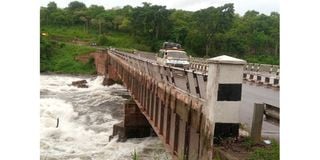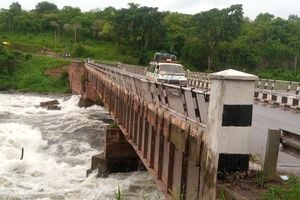
A commuter taxi crosses Karuma Bridge. PHOTO | BILL OKETCH
At about 5.45am, Lawrence Waka drives his delivery van—a Probox—from Kamdini Town centre to Atura Landing Site.
It is at this former ferry docking site, located 12km away from Kamdini, where Waka picks newspaper copies and courier packages for circulation.
Since being assigned the Lango Sub-region route, Waka has been domiciled in Kamdini Town, having previously planted his roots in Karuma Town. The closure of Karuma bridge nearly a fortnight ago has brought new pain points for his courier service.
“I have to dare this distance and bad road early enough. The readers don’t want to understand whether the bridge is closed or not. They want their copies delivered timely or else they reject it,” Waka said.
After a driver uses the Katulikire-Mutunda route to dispatch the courier items at Atura Village via the river, Waka says he does everything remotely possible to avoid the Masindi Port route as it could stall activities until 3pm.
“This is an increased distance and costs because the drivers incur additional fuel costs, but the motorboat operators charge you handsomely to cross the river. For example, every day I have to pay Shs35,000 to get the items across the river, both incoming and returns,” he disclosed.
Air of resignation
James Kokas Onapi, the Nation Courier Uganda Business manager, confirmed that the Karuma bridge closure has fashioned a sledgehammer blow to the courier business. Huge costs are being incurred in terms of fuel used to cover the extensive distances. There is also the matter of the charges slapped by the Uganda Wildlife Authority (UWA) on trucks and travellers accessing the northern region through Murchison Falls National Park.
“We are likely to increase the rates for northern routes,” Onapi says with an air of resignation.
Onapi also cites fees that UWA slaps on an automobile (Shs40,000) and its driver (Shs25,000), bringing the round-trip fare to Shs130,000.
“When you look at the costs of fuel now, we have to use a longer route, we no longer use the shorter route and we have to go via the park, but that means more fuel for a van coming to Gulu or going to Lira,” he reveals, adding: “Most importantly, the courier now arrives there much late compared to what clients expect of us and how we usually deliver. We have a lot of delays, a driver has to spend about four hours crossing the park at a 40km/hr speed.”
Onapi says his team wants “to find an alternative to using motorboats to cross the river” for the newspaper deliveries but the complications encountered in delivering courier packages mandates the use of the longer route. Little wonder, local leaders keep pushing for the grievances to be swiftly redressed.
“Right now, transportation is quite challenging. There is a lot of congestion at the only route, which is Masindi Port to Loro and Masindi Port to Lira. For us in Kiryandongo, we benefit from Gulu and Lira referral hospitals, Lacor and Atapara hospitals, but with this congestion, there will be a lot of time lost in rescuing the lives of the people,” Edith Aliguma Adyeri, the Kiryandongo District chairperson, told President Museveni during last week’s commissioning of Karuma Hydropower Dam.
“We request that you operationalise the former route which comes from Katulikire, Mutunda to Atura. Formerly, there was a ferry. For now, we also request a ferry so that we decongest the route from Masindi Port, the other side. If a ferry is not got, for now, we could have several motorboats,” she added.
Acknowledging the challenges travellers now face after the bridge’s closure, President Museveni described the proposed solution of a ferry at Atura Landing Site as “a good idea.” He promised to get the ferry at the soonest.
Trade impact
When Monitor visited Atura Landing Site last Thursday, scores of food and beverages vendors could be seen setting up their stalls to tap into the few business opportunities passengers who dare to cross the Nile River on motorboats and canoes can offer.
“I was formerly selling roasted chicken and soft drinks in Karuma Town and here I will only be selling soft drinks. We have observed in the past four days that most people crossing from here don’t buy chicken,” Rogers Oming, a vendor, said.
While at Karuma, Oming roasted and sold approximately 10 chickens each day. Consequently, he pocketed about Shs45,000 in profit.
Karuma bridge, whose construction was completed in 1962, is a major link and gateway between the midwestern and northern Uganda, as well as West Nile Sub-region.
Repair works on the bridge are ongoing after its Shs6.8 billion contract was recently handed over to the UPDF’s National Enterprise Corporation (NEC) and China Railway 7 Group. Motorists now have to use alternative routes to reach their intended destinations. Those from Kampala heading to Gulu/West Nile are advised to use Luwero-Kafu-Masindi-Paraa (Murchison Falls National Park) road to connect to Pakwach or Gulu via Olwiyo and vice versa for motorists from Gulu/West Nile.
Motorists headed to Lira can use the Rwenkunye-Apac route via the Masindi port ferry, whereas Lira-bound motorists can also use Iganga-Nakalama-Tirinyi-Pallisa-Kumi-Soroti-Lira route and vice versa.
For traffic from Kampala to Gulu, travellers can branch off from Kafu to the Masindi-Paraa-Pakwach route and connect to Gulu through Anaka. This route increases the distance by 85kms compared to the 335km drive between Uganda’s capital and the biggest city in northern Uganda.
With drivers estimating that a bus—the vehicle of choice for passengers on the route—covers six kilometres on a litre, it means the 85 kilometres would require 211 extra litres. These added litres are now the order of the day for travellers from Pader, Kitgum, Agago, Abim, and Otuke, who can access Kampala through Lira, Apac-Masindi Port or the eastern route.
Road to perdition?
Monitor accessed a document tabulated by the Gulu Public Transporters Association detailing the distances in kilometres of the optional routes.
Route A - (Gulu-Murchison Falls National Park-Kampala), Gulu-Packwach (120km), Packwach-Masindi (111km) and Masindi-Kampala (213km) now totals 444km, up from the previous 336km.
Route B—Gulu-Lira, Masindi Port Ferry-Kampala; Gulu-Lira (130km), Lira-Apac (64km), Apac-Masindi Port (64km), Masindi Port-Kampala (196km)—now totals 454km.
Route C—Gulu-Pallisa-Kampala: Gulu-Kumi (270km), Kumi-Tirinyi (67km), Tirinyi-Kampala (190km)—adds up to 527km.
Route D is Gulu-Bulisa-Kampala: Gulu-Pakwach (120km), Pakwach-Bulisa (54km), Bulisa-Hoima (90km), Hoima-Kampala (202), totalling to 468km.
Besides being the only direct gateway to a region (northern Uganda) that accounts for 20 percent of Uganda’s population, Karuma bridge also contributes to the country’s tourism industry.
For Robert Ekwang, a truck driver who transports wholesale traders’ goods from Kampala to Kitgum, having to pass through Murchison Falls National Park, has pushed his fuel costs up from Shs0.9m to Shs1.2m for a one-way trip. He says the eastern route is even more punishing on the wallet.
Mr Suleiman Ngondi, the sustainability and communications manager at Uganda Breweries Ltd, said last week that the costs of shipment of their logistics to the northern market has significantly shot up.
“The prices of our products will definitely not change in the short-run, although the situation is being assessed,” he revealed, adding that manoeuvring longer distances is now the new normal.
Back at Atura Landing site, passenger taxi cars are crowded on either ends of the river waiting to ferry passengers to Kamdini and Bweyale towns. To cross, a passenger is charged Shs5,000 on a canoe (25 minutes) or a motorboat (12 minutes).
“This is the only option and sometimes passengers demand us to operate until 7pm, but ideally, we stop at 6pm,” Jasper Okello, a motorboat operator at Atura Landing Site, said.
Robert Adongakulu, an entrepreneur and farmer in Gulu City, explains that the closure of the bridge will see “the economy of the north … nearly collapse.” He describes as untenable any move to pass “the astronomical cost of transport and other fees” to end users, who themselves are struggling financially.
Farooq Akangi, a trucker and hardware dealer who transports cement from Kampala to the Elegu border town in Amuru District, said the route changes have forced a rise in prices, with the price of cement now ranging between Shs34,000 to Shs37,000.
“Sales are dropping every time because prices are going up, but also we cannot give up to say we are closing because the transportation costs have gone higher,” Akangi said.
“I previously spent 11 hours on the road and drove 450km, but right now it takes us 16 hours on the road and up to 620km.”




